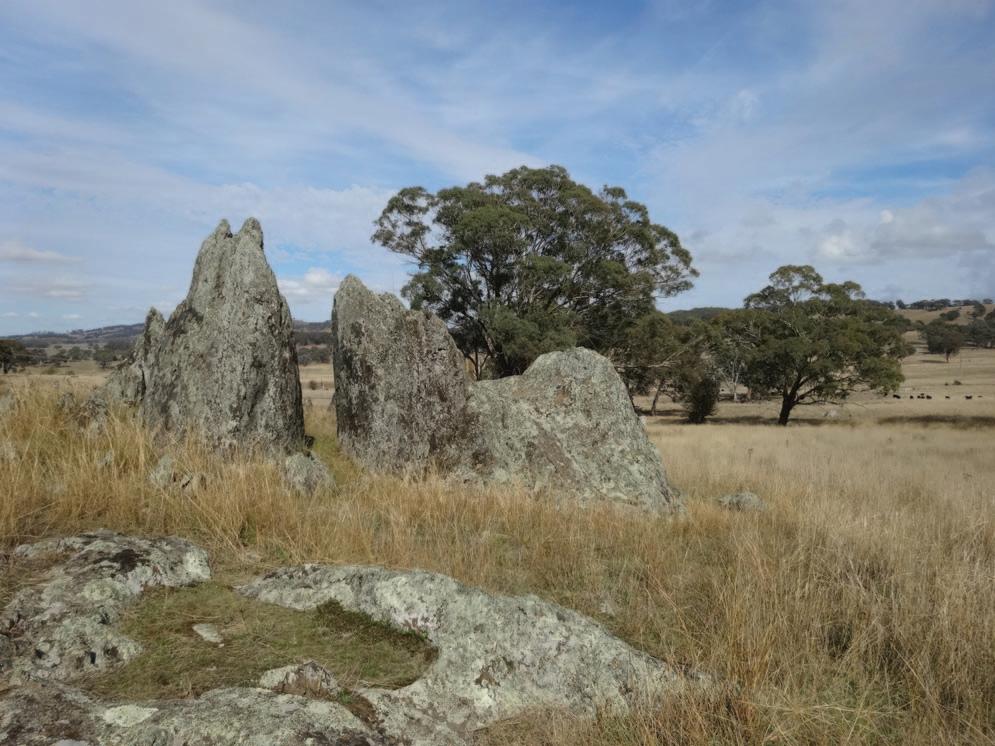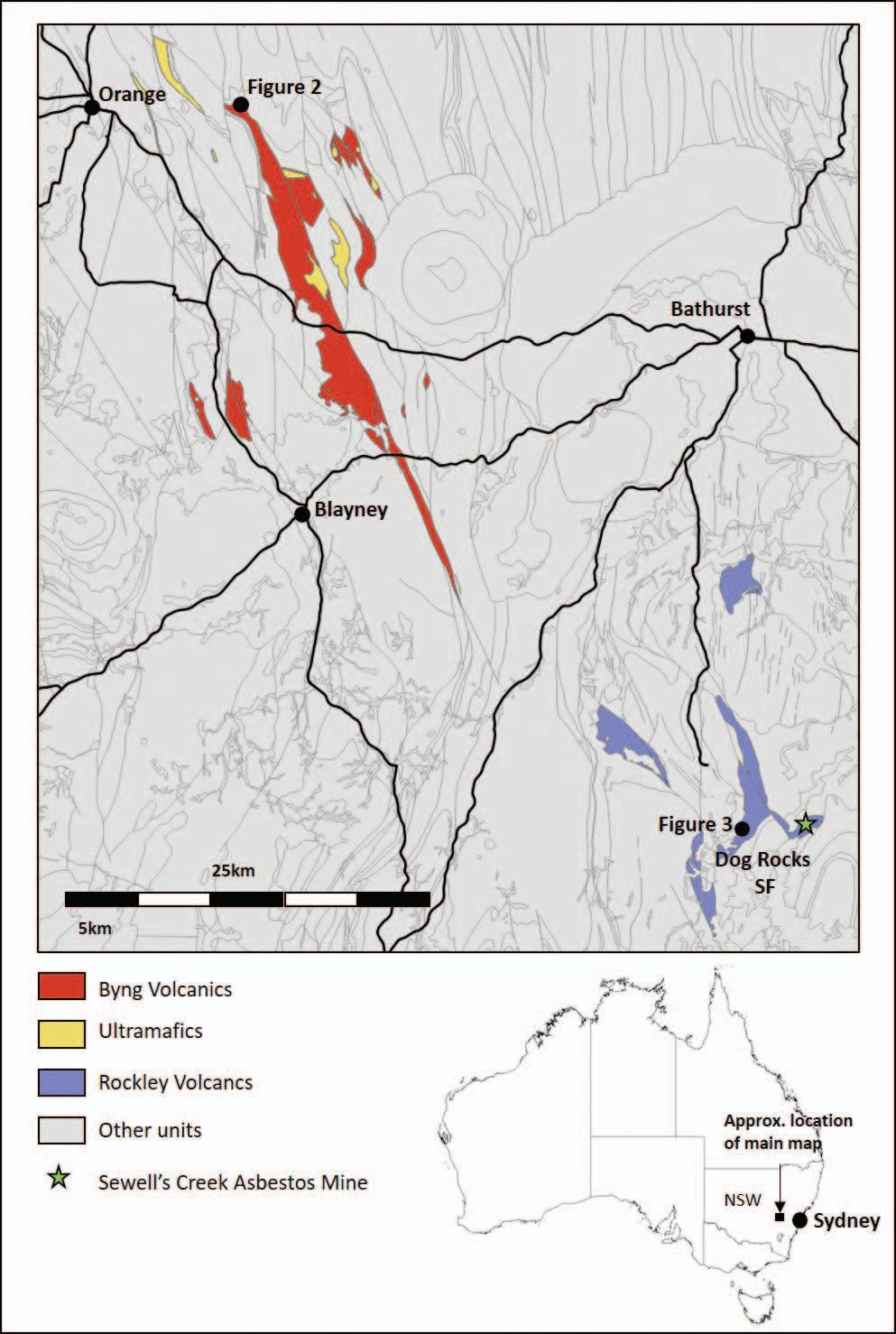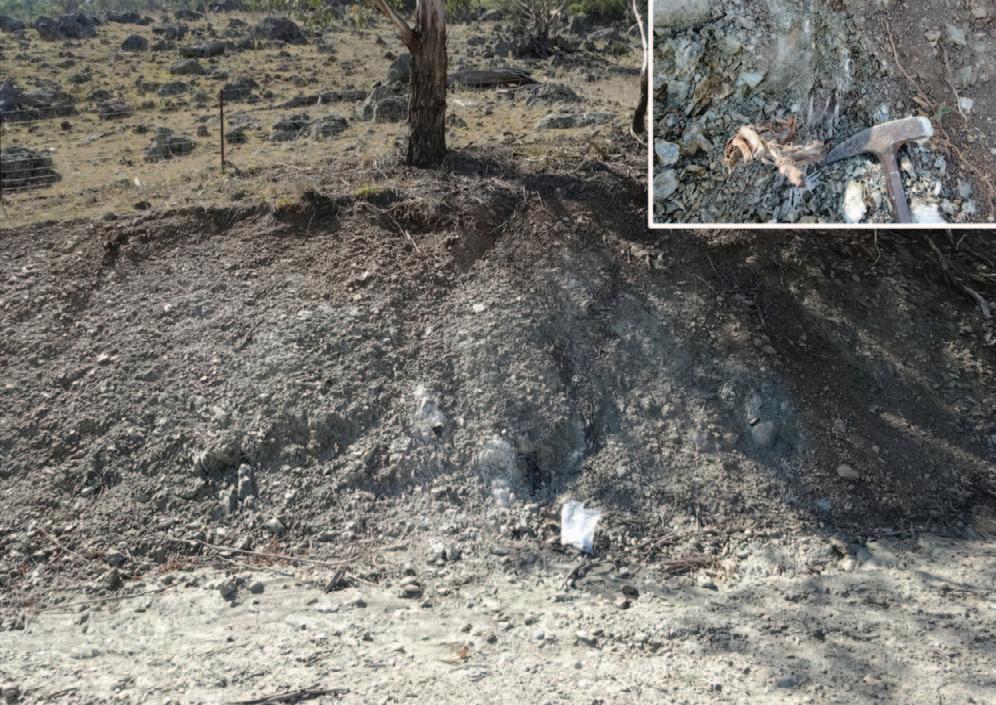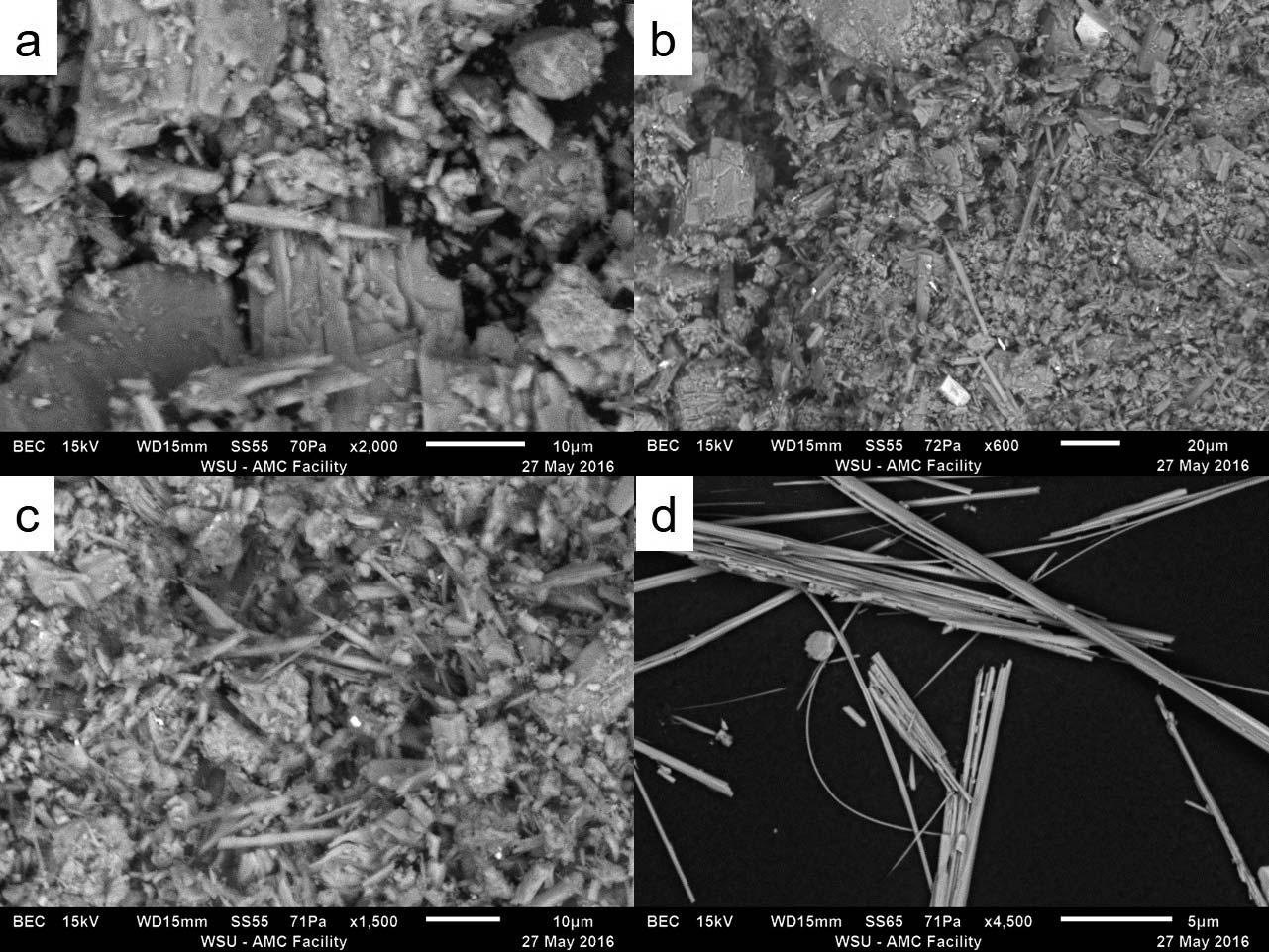
8 minute read
Fibrous Tremolite in Central New South Wales, Australia
from EEG Journal - February 2020 Vol. XXVI, No. I (2)
by Association of Environmental & Engineering Geologists (AEG)
MARC HENDRICKX* Marc Hendrickx and Associates, Australia, P.O. Box 61, Berowra Heights, New South Wales, Australia, 2082
Key Terms: NOA, Asbestos, Tremolite, Elongated Mineral Particles, Australia, Toxicology
ABSTRACT
Tremolite schists in Ordovician meta-volcanic units in central New South Wales (NSW) consist of fine fibrous tremolite-actinolite. They host tremolite asbestos occurrences, and small quantities of asbestos were mined from narrow vein deposits in central NSW during the last century. When pulverized, the tremolite schist releases mineral fragments that fall into the classification range for countable mineral fibers and may be classed as asbestos despite not having an asbestiform habit. The ambiguity in classification of this type of natural material raises significant health and safety, legal, and environmental issues that require clarification. While the health effects of amphibole asbestos fibers are well known, the consequences of exposure to non-asbestiform, fibrous varieties is not well studied. This group of elongated mineral particles deserves more attention due to their widespread occurrence in metamorphic rocks in Australia. Toxicological studies are needed to assess the health risks associated with disturbance of these minerals during mining, civil construction, forestry, and farming practices.
INTRODUCTION
Lower Ordovician meta-volcanics in central New South Wales (NSW) are host to minor asbestos occurrences. Some of these were mined in the first half of the 1900s, yielding small quantities of poorquality tremolite asbestos used mainly to line boilers (Hendrickx, 2009). The host rock to asbestos occurrences are tremolite-actinolite-chlorite schists in the Rockley, Byng, and Sofala Volcanics that form distinctive outcrops throughout the region (Figure 1). When crushed for industrial use as a road construction material, the schists release crystal fragments with size and aspect ratios that fall into the classification for countable fibers and may be classed as asbestos. These elongated mineral particles (EMPs) raise health and safety, legal, and environmental issues that require clarification.
*Corresponding author email: marchgeo@gmail.com
This article documents preliminary results of a geological assessment for natural occurrences of asbestos (NOA) undertaken in Rockley and Byng Volcanics between Orange and Dog Rock State Forest in central NSW (Figure 2). The assessment included review of available geological information, such as new NOA potential maps (HACA, 2015a, 2015b), and included new geological mapping and assessment of regional airborne geophysics (aeromagnetic and radiometric datasets) to improve base geology maps along with sampling and mineral analysis. The work was undertaken following discovery of tremolite asbestos veins during minor roadworks (Figure 3).
GEOLOGICAL SETTING
The area occurs in the eastern Lachlan Fold Belt, a major geological province in eastern Australia that was active from the Cambrian to the Carboniferous. The geological history of the area includes marine sedimentation in troughs and basins adjacent to a long volcanic arc that was active through the Ordovician to early Silurian. Ordovician volcanism and sedimentation across the central Lachlan Fold Belt was terminated in the early Silurian by a regional deformation event termed the Benambran Orogeny. This caused extensive shortening across the region, folding and
Figure 1. Outcrop of tremolite-actinolite-chlorite schist from Byng Volcanics, near Orange, central NSW (−33.27537, 149.19834).

Figure 2. Geological map highlighting location of outcropping Byng and Rockley Volcanics and other locations mentioned in the text. From Pogson and Watkins (1998).
below. In thin section, the tremolite schist comprises altered clinopyroxene phenocrysts in a strongly foliated matrix of laths of tremolite, chlorite and very fine, fibrous and asbestiform tremolite groundmass. Relict pyroxene crystals in the tremolite schist suggest a mafic volcanic origin, possibly a basaltic lava.

Figure 3. Tremolite-actinolite-chlorite schist in Rockley Volcanics, Dog Rocks Road. Inset shows narrow slip fiber vein with tremolite asbestos (−33.73434, 149.58693).
faulting the rocks, and was accompanied by granite intrusion and regional metamorphism to actinolitebiotite grade (greenschist facies). Ultramafic and mafic volcanic and intrusive rocks were metamorphosed during this event, and primary igneous mineral assemblages were replaced by metamorphic minerals, including amphiboles (Pogson and Watkins, 1998).
Dog Rocks Area
Geological assessments for NOA were undertaken in a number of areas across the region underlain by Rockley and Byng Volcanics. This report focuses on results from the Dog Rocks State Forest area, approximately 35 km south of Bathurst in central NSW (see Figure 2) 150 km west of Sydney.
Late Ordovician Rockley and Byng Volcanics form a mixed unit comprising metamorphosed siltstone, shale, chert, and sandstone along with metamorphosed mafic and ultramafic volcanic rocks (meta-basalt, meta-gabbro, amphibolite, pyroxenite, and serpentinite with tremolite-chlorite schist). Byng Volcanics include a few larger metamorphosed ultra-mafic and serpentinite bodies that contain both tremolite and chrysotile asbestos (Hendrickx, 2009). The Rockley Volcanics occur in the Dog Rocks area (Figure 2) and are divided into four unnamed units— Ocr, Ocrc, Ocru, and Ocrs—based on the dominant lithology (Pogson and Watkins, 1998). Asbestos mineralization occurs mainly in Ocru, which comprises tremolite-actinolite-chlorite schist (Figure 3) and minor meta-basalt. Approximately 30 narrow veins (<2 cm across) of asbestiform tremolite (slip fiber and cross fiber) were located in tremolite-chlorite schist and meta-basalt along the road across a 1-km section (Figure 3), and these are described in more detail ASBESTOS OCCURRENCES
Asbestos was first reported in the Rockley area at Briar Park in 1877, just west of the Dog Rocks State Forest. Asbestos was also worked at Sewells Creek, and 50 tons was reportedly produced in 1942 but not sold. The location of this mined material is not known, but it may be the source of dumped mine waste material found in the area during this work.
The main type of asbestos is tremolite-forming discrete narrow (up to 2 cm wide) slip fiber veins in metamorphosed mafic volcanics (tremolite-actinolitechlorite schist). Fibrous tremolite is also present within the fine-grained matrix of tremolite-chlorite schist host rock. This is different in style to serpentinite-hosted asbestos deposits found elsewhere in NSW. Serpentinitehosted deposits, such as those from the Coolac-Tumut area, consist of very fine closely spaced veins of cross fiber and slip fiber chrysotile disseminated through the host rock (Hendrickx, 2009).
The asbestos vein system at Dog Rocks is inferred to form a semi-continuous elongate zone parallel to regional structures. It is inferred that this vein system has been truncated by a prominent transverse fault structure where tremolite asbestos was mined at Sewell’s Creek. The fault structure appears to be unconformably overlain by Late Silurian meta-sedimentary rocks to the east of Dog Rocks State Forest. This suggest the asbestos mineralization predates faulting and is likely associated with the early Silurian Benambran Orogeny; hence, younger rocks are unlikely to have this style of asbestos mineralization.
Scanning electron microscopy (SEM) with energy dispersive X-ray spectroscopy (EDS) assessment on tremolite schist and asbestos veins from the Dog Rocks Road section was undertaken. Ground samples of tremolite schist broke down to a mix of fine tremolite cleavage fragments and non-fibrous crystal fragments (Figure 4a, b, and c). The proportion of fibers classed as respirable ranged up to about 1%–5% for any given field of view on the SEM. Generally, the length of these fibers was between 7 and 20 μm, with typical aspect ratios of about 10–20. Further SEM analysis is required to determine the precise mineralogical characteristics of this material.
SEM imagery of asbestiform fibers from the veins confirms the asbestiform nature of the vein material. Aspect ratios >100 are very common. Individual fiber

Figure 4. SEM images of crushed schist (a, b, and c) note acicular and elongate crystal fragments and tremolite asbestos (d).
bundles are clearly observed breaking into finer fibrils approximately 0.1–0.2 μm wide (Figure 4d).
DISCUSSION
The definition of a “countable fiber” includes elongate and fibrous mineral fragments that do not necessarily have an asbestiform habit. These fragments have been defined as EMPs (ANSES, 2014). Detailed testing using SEM or transmission electron microscopic methods help to differentiate EMPs from true asbestiform particles. However, ambiguity in what constitutes a “fiber” and lack of information and some uncertainty about the toxicological properties of these elongate amphibole mineral particles are hampering concise assessment of the health risks.
There are mixed views about the health dangers posed by respirable non-asbestiform amphiboles. Williams et al. (2013) concluded, “No evidence of demonstrable cancer effects from exposure to nonasbestos amphiboles that may be counted as fibers, under certain assessment protocols, was found.” However a review by the French Agency for Food, Environmental, and Occupational Health and Safety (ANSES, 2014) concluded,
There is no reason to make a distinction between the cleavage fragments meeting the “WHO” dimensional criteria for fibers (L > 5 µm; D < 3 µm and L:D > 3:1) and asbestiform fibers of calcic and sodic-calcic EMPs (Elongated Mineral Particle), in particular due to the uncertainties and difficulties related to their characterisation and to their differentiation by routine analytical methods.
The consequences of confusion about “fiber” terminology and classification were highlighted by Thompson et al. (2011), who showed for the United States
that “based on the regulatory definition, 13% of soil pedons and 5% of soil horizons in the U.S.A. are ‘naturally contaminated.’ ” Similar issues arise with confusion over terminology and the widespread occurrence of amphiboles in the geological environment in eastern Australia.
CONCLUSIONS
NOA occurrences in Ordovician meta-volcanic rocks in central NSW comprise tremolite asbestos and EMPs, which pose a problem of classification when working on the assessment of NOA hazard. EMPs have not been fully considered in assessments of NOA exposure risk, and further work is required to better understand the distribution and health risks associated with these non-asbestiform amphiboles, including toxicological studies.
REFERENCES
ANSES, 2014, Health Effects and the Identification of Cleavage Fragments of Amphiboles from Quarried Minerals: French Agency for Food, Environmental, and Occupational Health and Safety Opinion Request No. 2014_SA_0196 MaisonsAlfort. https://www.anses.fr/en/system/files/AIR2014sa0196 RaEN.pdf HACA, 2015a, Mapping of Naturally Occurring Asbestos in NSW–Known and Potential for Occurrence: Heads of Asbestos Coordination Authority, NSW Trade and Investment, Division of Resources and Energy. HACA, 2015b, Naturally Occurring Asbestos in NSW NOA Potential Maps: Heads of Asbestos Coordination Authority, NSW Trade and Investment, Division of Resources and Energy. https://trade.maps.arcgis.com/apps/PublicInformation/index. html?appid=87434b6ec7dd4aba8cb664d8e646fb06 Hendrickx, M., 2009, Naturally occurring asbestos in eastern Australia: A review of geological occurrence, disturbance and mesothelioma risk: Environmental Geology, Vol. 57, No. 4, pp. 909–926. Pogson, D. J. and Watkins, J. J., 1998, Bathurst 1:250000 Geological Sheet SI/55-8: Explanatory Notes: Geological Survey of New South Wales, Sydney. Thompson, B. D.; Gunter, M. E.; and Wilson M. A., 2011, Amphibole asbestos soil contamination in the U.S.A.: A matter of definition: American Mineralogist, Vol. 96, pp. 690–693. Williams, C.; Dell, L.; Adams, R.; Rose, T.; and Van Orden D., 2013, State-of-the-science assessment of non-asbestos amphibole exposure: Is there a cancer risk?: Environmental Geochemistry and Health, Vol. 35, No. 3, pp. 357–377.










